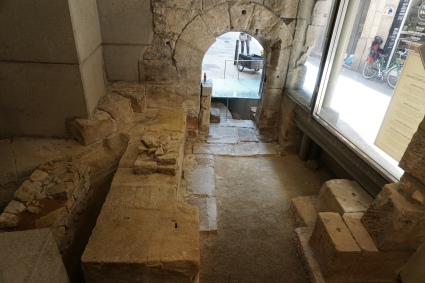Barcelona was founded in 15 BC by the Romans, and you can find evidence of this with just a little digging (Get it? Digging?). When I walk through this city I see ancient mixing with modern, and it reminds me that some streets I walk on have existed longer than the U.S. has been an established country.
The Patrimoni Cultural page from the Generalitat de Catalunya has a great overview of Barcelona’s (and Catalonia’s) best historic sites. The website has a timeline ranging from the Middle Palaeolithic Age (which started 300,000 years ago) to present day, with marks like Ancient Rome, the Renaissance and Modernism along the way. Under each section of the timeline is a list of sites in Catalonia that are relevant to that time period.
Some sites the website highlights that are located in Barcelona include the Centre Excursionista de Catalunya, which has three columns preserved from a Roman temple that used to be the center of the Forum, the Roman streets that are preserved in Plaça del Rei, the Porta de Mar and remnants of the Roman wall that once surrounded old Barcelona.

Ancient ruins are one element of Barcelona’s landscape that come from the distant past, but there have also been more recent forces that have influenced the landscape of Barcelona, one of the most impactful being Ildefons Cerdà’s Eixample expansion project. According to an article titled “Story of cities #13: Barcelona’s unloved planner invents science of ‘urbanisation’” by Marta Bausells for The Guardian, the plan destroyed the wall that was “suffocating” the city and created an area that was four times the old town’s size, with wider streets and a grid structure. The wall was destroyed in 1854 and the expansion began in 1859, but Cerdá didn’t receive the credit he deserved until the 1990s. Bausells says, “These days, Barcelona is consistently praised as an urban success story. And its fortunes are inextricably linked to Cerdà’s work, which propelled it, in the words of Permanyer, ‘from a provincial town where it was difficult to live, to a truly modern city’.”

Barcelona has seen even more changes since Eixample. In fact, the Generalitat de Catalunya’s “Contempory Barcelona” webpage says that since the 1992 Olympics, a new Barcelona has been constructed, one that is more accessible, more branded and appeals to the masses. Examples of this increased accessibility include adding escalators to Plaza Espanya and creating an extensive network of metro routes underground.
It’s questionable whether or not this is a good thing, as it has bolstered the tourism industry in the city and led to problems for locals like gentrification. This has led to some anti-tourism sentiment, and it’s not uncommon to see graffiti that reads “Tourists Go Home” near major attractions in Barcelona.

Sources:
Patrimoni Cultural: Navigate through time – Generalitat de Catalunya http://patrimoni.gencat.cat/en
“Story of cities #13: Barcelona’s unloved planner invents science of ‘urbanisation’” – Marta Bausells https://www.theguardian.com/cities/2016/apr/01/story-cities-13-eixample-barcelona-ildefons-cerda-planner-urbanisation
Contemporary Barcelona – Generalitat de Catalunya http://patrimoni.gencat.cat/en/collection/contemporary-barcelona
